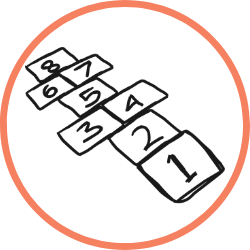

Play Hopscotch
Playing hopscotch, though a simple childhood game, can genuinely contribute to happiness and overall well-being in several ways. Here's how:
1. Boosts Mental Well-Being
Engaging in light-hearted play helps release endorphins (the brain’s “feel-good” chemicals), which improve mood. Focusing on jumping, balancing, and counting numbers can serve as a form of mindful movement, helping reduce stress and anxiety.
2. Encourages Physical Activity
Hopscotch involves jumping, balancing, and coordination, which gets the blood pumping and improves energy levels. Even a few minutes of physical play can reduce muscle tension and improve sleep quality—both important for emotional health.
3. Fosters Social Connection
Playing hopscotch with others creates opportunities for bonding, laughter, and positive interaction. For adults, playing a familiar childhood game can rekindle joyful memories and a sense of innocence.
4. Promotes Outdoor Time
Often played outside, hopscotch encourages time in nature, which is linked to lower stress and increased feelings of happiness. It provides a screen-free activity that refreshes the mind and reduces digital fatigue.
5. Builds Confidence & Joy Through Mastery
Successfully completing a hopscotch grid brings a small sense of accomplishment. Setting and meeting small physical goals (like getting to the end of the grid) can be surprisingly satisfying.
If you're looking for a quick mood boost or a way to reconnect with playful joy, hopscotch is an easy, no-cost option that combines movement, nostalgia, and fun—all of which are great for happiness.
Check out our Hopscotch suggestions.
Hopscotch
Suggestions:
As an Amazon Associate I earn from qualifying purchases.
Kids Chalk
Address: JSBN Designs, Lytchett House, 13 Freeland Park, Wareham Road, Poole, Dorset, BH16 6FA.








